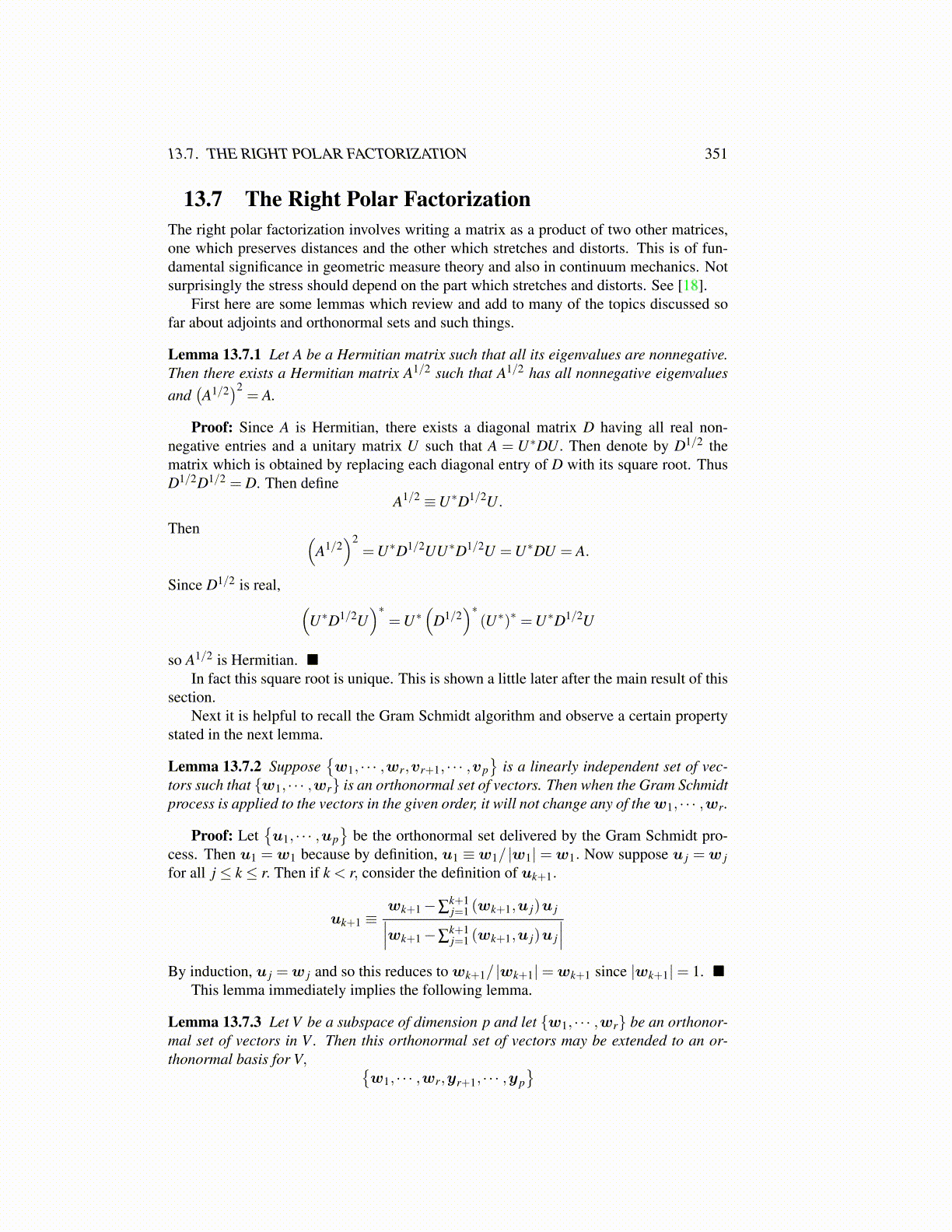
13.7. THE RIGHT POLAR FACTORIZATION 351
13.7 The Right Polar FactorizationThe right polar factorization involves writing a matrix as a product of two other matrices,one which preserves distances and the other which stretches and distorts. This is of fun-damental significance in geometric measure theory and also in continuum mechanics. Notsurprisingly the stress should depend on the part which stretches and distorts. See [18].
First here are some lemmas which review and add to many of the topics discussed sofar about adjoints and orthonormal sets and such things.
Lemma 13.7.1 Let A be a Hermitian matrix such that all its eigenvalues are nonnegative.Then there exists a Hermitian matrix A1/2 such that A1/2 has all nonnegative eigenvaluesand
(A1/2
)2= A.
Proof: Since A is Hermitian, there exists a diagonal matrix D having all real non-negative entries and a unitary matrix U such that A = U∗DU. Then denote by D1/2 thematrix which is obtained by replacing each diagonal entry of D with its square root. ThusD1/2D1/2 = D. Then define
A1/2 ≡U∗D1/2U.
Then (A1/2
)2=U∗D1/2UU∗D1/2U =U∗DU = A.
Since D1/2 is real, (U∗D1/2U
)∗=U∗
(D1/2
)∗(U∗)∗ =U∗D1/2U
so A1/2 is Hermitian. ■In fact this square root is unique. This is shown a little later after the main result of this
section.Next it is helpful to recall the Gram Schmidt algorithm and observe a certain property
stated in the next lemma.
Lemma 13.7.2 Suppose{w1, · · · ,wr,vr+1, · · · ,vp
}is a linearly independent set of vec-
tors such that {w1, · · · ,wr} is an orthonormal set of vectors. Then when the Gram Schmidtprocess is applied to the vectors in the given order, it will not change any of the w1, · · · ,wr.
Proof: Let{u1, · · · ,up
}be the orthonormal set delivered by the Gram Schmidt pro-
cess. Then u1 =w1 because by definition, u1 ≡w1/ |w1| =w1. Now suppose u j =w jfor all j ≤ k ≤ r. Then if k < r, consider the definition of uk+1.
uk+1 ≡wk+1−∑
k+1j=1 (wk+1,u j)u j∣∣∣wk+1−∑k+1j=1 (wk+1,u j)u j
∣∣∣By induction, u j =w j and so this reduces to wk+1/ |wk+1|=wk+1 since |wk+1|= 1. ■
This lemma immediately implies the following lemma.
Lemma 13.7.3 Let V be a subspace of dimension p and let {w1, · · · ,wr} be an orthonor-mal set of vectors in V . Then this orthonormal set of vectors may be extended to an or-thonormal basis for V, {
w1, · · · ,wr,yr+1, · · · ,yp}